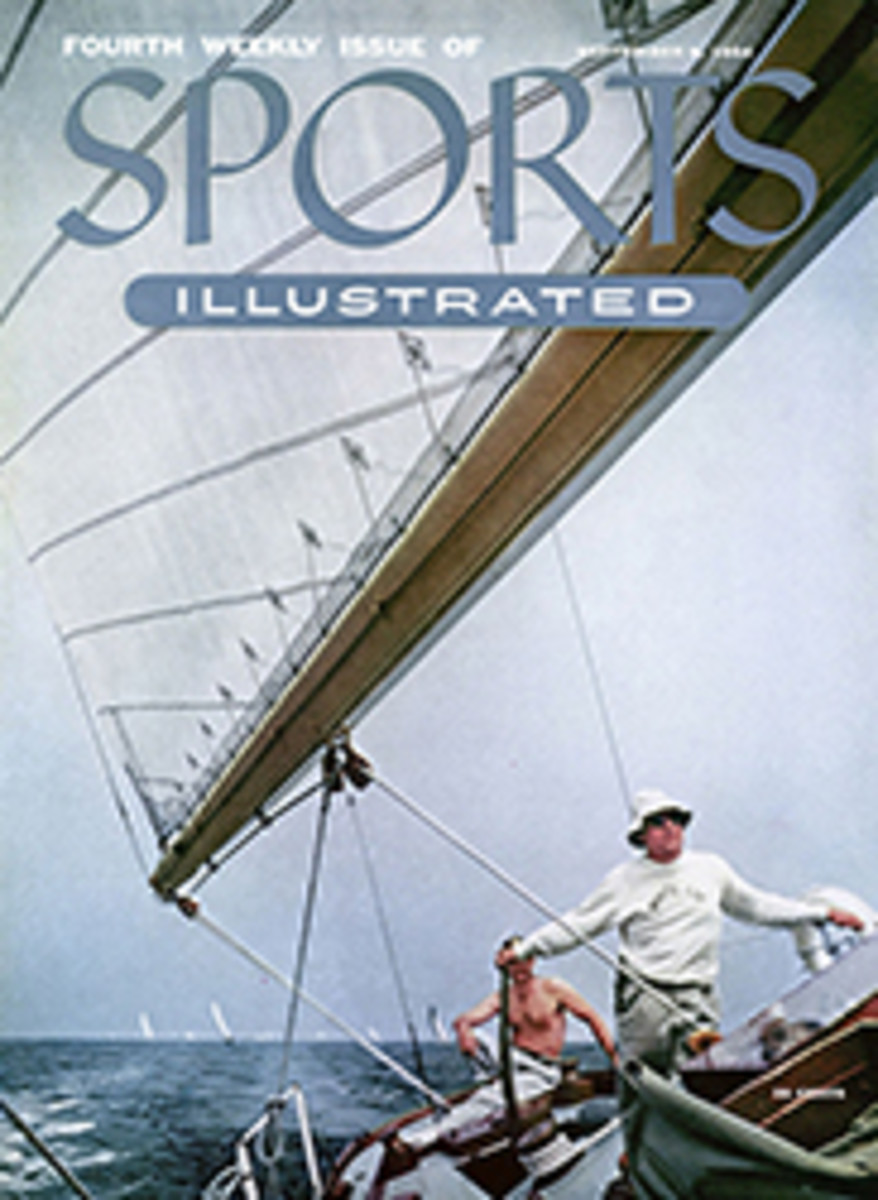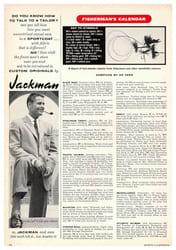
NEW VOGUE FOR AN FAVORITE
Four years ago the owner of a large black standard poodle walked the dog through the downtown section of Nashville, Tenn. A prim, self-assured lady passing by asked her young daughter if she knew what kind of dog it was. "No, ma'am," the child replied. "It's an Airedale," her mother said, and proceeded knowingly down the street.
The odds that the same scene would be repeated today, while still considerable, are far less than they were in 1950. For the poodle is enjoying a vogue in America which in kennel circles is approaching the proportions of a minor boom. In 1930 the American Kennel Club listings—the barometer of any breed's progress—reported only 50 registered poodles. The figures for 1940 showed improvement: 623. But last year the number was 8,167, a rise of 33% over 1952. With 25% more persons owning nonregistered purebreds, this makes the poodle the 10th most popular dog in the country.
But even more than the poodles themselves, it is their likeness, stamped on just about any gewgaw or artifact that can take the impression, that has made the breed known in America. It is a rare shopper who can browse through gift shops or Christmas cards without encountering a poodle pirouetting or standing on its head or otherwise engaging in some form of human endeavor. Poodle haircuts for women and imitation and genuine poodle cloth lend further evidence that the poodle is having his day.
All the publicity, much of it effete, has tended to give the poodle a certain notoriety as a coddled dog that requires constant care and grooming. The reputation is undeserved. Under a cloak of aristocratic ruffles and harlequinesque pompons hides a hard hunting body which reflects the poodle's ancestry as a sporting dog.
The poodle has lost little of its heritage as a fine hunter and retriever and a magnificent swimmer. It combines these qualities with a remarkable flair for civilization which has caused many to regard it as almost human. Certainly few dogs possess more intelligence. The poodle is extremely quick to learn, a fact which, coupled with its easy grace and natural gaiety, has made it a wonderful circus dog who loves to be the center of attention. It is as a pet and charming companion, however, that the poodle is especially valuable. The dog is loyal, anxious to please, responds easily to training and is gentle with children.
The dual personality of field dog and drawing-room showpiece has been a characteristic of the poodle since its earliest appearance. The first poodles came from Central Europe some 2,000 years ago. They were used as retrievers, and it was this sturdy occupation that was responsible for clothing them in the rococo dress that has stamped the lighter side so indelibly in the popular consciousness. The heavy insulation of hair on the poodle's chest and neck was left there by early hunters to protect the dog's heart and lungs and keep him warm when he swam in icy waters after fallen water fowl. The shaved hindquarters facilitated his swimming while the tufts of hair left on legs and hips shielded the joints where the blood ran close to the skin. Even the top-knot and powder puff tail had a function. They told the hunters where the dogs were when partially hidden by undergrowth.
Poodles were late in coming to the U.S. (the first in 1878), and when they did their popularity was confined solely to the east coast. Most early imports were from France and Germany, though it was not until 1887 that a black standard poodle was registered with the A.K.C. Show poodles wore the Continental clip (see chart page 31), while pets often went untrimmed. These dogs, long-bodied, short-legged, coarse-headed specimens with short muzzles, somewhat resembled small sheep dogs.
After a brief spate of popularity around the turn of the century, the poodle practically disappeared from American shores. Only one was shown in the Westminster show in New York in 1922. A revival of interest in the early '30s came about as a result of the earnest efforts of a few breeders who imported exceptional poodles of great intelligence and ideal temperament. By 1935 the poodle had arrived again. A large white standard, Ch. Nunsoe Due de la Terrace of Blakeen, owned by Mrs. Sherman Hoyt, won best in show at Westminster. The war interrupted breeding, but since 1946 there has been a steady rise in the number of registered poodles every year.
Standards for poodles are set by the poodle clubs of America and approved by the A.K.C. Three types are recognized: the standard, the miniature and the toy, declining in size in that order. All three have been known to have been in existence for at least 600 years. But general acceptance has only come for the smaller types after breeders have succeeded in making them conform in all specifications to the standards, except size. This usually means lengthening the muzzle and legs and refining the head. The toy was the last to be accepted as an equal among its relatives. In 1942 the A.K.C. conceded that the former outcast had finally conquered its shortcomings and was fit company at shows with other poodles. Today toys are actually winning more show prizes than standards and miniatures, and often win over the best of other breeds.
Outside of judging points (see chart, page 27) and type of clip the most discussed feature of poodles is their color. Years ago poodles were bred regardless of color combinations. Today only solid colors, with certain exceptions, are permitted in U.S. shows. As a result, breeders are loath to sell any dogs which do not carry the usual colors, black, white, cream, apricot, café au lait, chocolate, dark brown, dark gray, silver or blue poodle. France and Germany are much more stringent in their rules, allowing only white, black and brown. England, chary with its sizes (only two are recognized), is as liberal as the U.S. with color.
One factor that has inhibited a more rapid growth of the poodle population in this country is their high cost. Fine poodles stand at stud with fees ranging up to $500. Some imports have cost $5,000 while reported prices for domestic poodles have gone as high as $3,000. Poodles of $500 or so should be free from serious faults and be of clear color. The average price for pet poodles is slightly over $100.
Some prospective buyers have shrunk from undertaking the care of a poodle. Most people think of poodles as creatures that take as much primping at their toilet as M me. Pompadour. For show purposes that is probably so. For pet owners, though, a once-a-week schedule for ears (which should be kept clear of wax), teeth, nails and a brushing of the coat is sufficient, with a trim at the barber's (probable cost, $5 to $15, depending on the size of dog and how complicated the clip) every third month. The female poodle is neater than the male, but neither has a doggy odor, nor do they shed hair.
In recent years the world of poodle breeders has been torn by a tug of war over the Continental and English Saddle clips versus the Royal Dutch cut. Advocates of the latter claim the Continental clip gives the poodle a freakish appearance and prevents many owners from showing their dogs in the ring. The poodle clubs have stoutly resisted change, holding that the Royal Dutch is a fad of the moment and that it is inutile. The Continental and English Saddle are, for all their frills, based on functional needs. George F. Foley, who stages the largest shows in the country, remains aloof from the turmoil. "A good horse is a good color," he says, "and a good poodle is a good poodle, regardless of barbering."
FIFTEEN PHOTOS
ILLUSTRATION
Corded poodle was put on display in the 1880s at Westminster show.
ILLUSTRATION
Stripped poodle shows usual fancy coat hides body of a hunting dog.
PHOTO
MARK KAUFFMAN
Displaying an elegant gaiety characteristic of all poodles, large or small, Pulaski Caesar Phantom John introduces his daughters Pompadour and Montespan. Johnny is eight and one half inches high at the shoulder and weighs five pounds. He is representative of the toy variety which is becoming increasingly popular.
TWO PHOTOS
MARK KAUFFMAN
Parti-colored poodles like Colleen and Patrick (above) can not compete in shows which recognize only solid colors and the show clip as modeled by Pinocchio (lower left).
FOUR ILLUSTRATIONS
PHOTO
SUPREME TEST for the champion poodle is his performance at annual Westminster Dog Show in Madison Square Garden before experts like Judge Earl Lounsbury (above).
POODLES ARE JUDGED BY THESE STANDARDS
EARS set low, preferably at eye level
NECK clean, fairly long, slightly arched; blending into long sloping shoulders well laid back
BACK short, strong, slightly hollowed
TAIL high-set, carried gaily
LOIN broad and muscular
THIGH well-developed
STIFLE well-bent
SECOND THIGH wide and muscular
HOCKS well-let down
ELBOWS turning neither in nor out
PASTERNS straight, strong
SKULL narrow, slightly arched, slight stop
EYES oval, set wide apart, soft and intelligent
CHEEKS flat
MUZZLE long and strong, not broad or deep
LIPS tight, not pendulous
EAR FEATHER, long and dense
COAT profuse, dense, even length; frizzy or curly, not silky
CHEST deep, narrow; ribs well-sprung
FORELEGS straight, muscular
FEET rather small, oval; toes well-arched and close; pads thick
THESE FAMOUS PEOPLE KEEP POODLES AS PETS
ARTURO TOSCANINI
SIR WINSTON CHURCHILL
ELIZABETH TAYLOR
MR. AND MRS. FREDRIC MARCH
JUAN PERON
OTHER PROMINENT OWNERS: Vincent Astor. Ed Sullivan, Bishop Sheen, Benny Goodman, Bob Topping, Judy Garland, Gary Cooper, Helen Hayes, Ambassador Clare Boothe Luce, David Sarnoff, Mary Martin, Senator Herbert Lehman, Alfred Sloan.
THE FOUR MOST POPULAR COAT CLIPS
PUPPY OR WORKING
CONTINENTAL
ENGLISH SADDLE
ROYAL DUTCH
Major controversy among poodle fanciers is: which coat clip should the American Kennel Club approve and permit at dog shows? Much to the chagrin of owners who prefer their pets trimmed in the Royal Dutch clip, the A.K.C. recognizes only the Continental or its variation, the English Saddle clip, and disqualifies all other barbering as "unorthodox." Only concession made by A.K.C. is that poodles under 12 months of age can be shown in the Puppy or Working clip.

